
This building was used as Melville’s as well as numerous other businesses in the late 19th and early 20th centuries. Image taken in 2015 by R&R See listings for the Ben Leader family, who operated the Melville’s Ladies Store for decades on R&R. The Charleston News and Courier of June 7, 1890 states – “A.E. Smith and Co., general merchants, do a very large and lucrative business and occupy and handsome and roomy store. Mr. Smith is the state agent of the Catawba Indians, who’s reservation is about seven miles from the city. “
F.H. BR&R HISTORY LINK: A. E. SMITH HOME LINK: EAST MAIN STREETThe Yorkville Enquirer reported on March 23, 1876 – “Julius Friedheim and A. Friedheim co-partnership, will operate under the name of A. Friedheim and Bro. as of this date, March, 1876.”
The Yorkville Enquirer reported on Aug. 10, 1876 – “Mr. A. Friedheim is building an addition to his storehouse.”
The Yorkville Enquirer reported on Jan. 2, 1879 – “sale of lot to J.N. McElwee, Jr., northside of Main St., in Rock Hill bounded by lots of W.L. Roddey, J.H. Hagins, B. Connor, F.H. Barber and others; $2.035.”
The Rock Hill Herald reported on April 8, 1880 – “Mr. Richard Morse began last week to make the brick for the stores of T.C. Robertson and Mr. A. Friedheim which are to be erected on Main Street. Mr. Friedheim began on Monday digging out the foundation and cellar for his building.”
The Herald also stated on April 15, 1880 – “The dimensions of the new building of A. Freidheim and Brothers will be 140 ft., by 31 feet.” The Herald further reported on May 27, 1880 – “The contractor, Mr. R.H. Morse, is getting along very well with the Friedheim building. Thompson and Wells are the contractors for the woodwork on this building. Mr. Morse also began laying the foundation of the Robertson Building. Mr. A.D. Holler is the contractor for the woodwork on this building.”
The Herald reported on July 8th, 1880 – “Mr. T.C. Ward, a capable carpenter, has recently completed a prescription case for T.C. Robertson and Co., and a reading desk for the Episcopal Church.”
The Yorkville Enquirer of Aug. 7, 1880 reported, “A. Friedheim and Co., have let the contract for a building to be erected between their building and the drugstore of J.B. Johnson on Main Street. It will be of brick with an iron and plat glass front. They will also remove the wood cornice on the Friedheim Store and replace it with metal.”
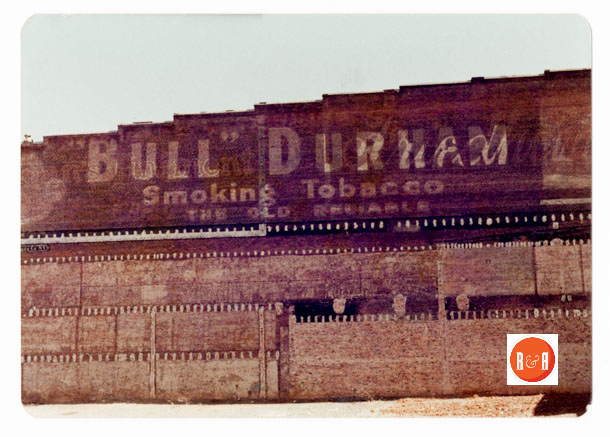
Courtesy of the Allen Collection
The Herald reported on Sept. 16, 1880 – “The new Masonic Hall in the Robertson Building has been dedicated. An alley for rolling at Ten Pins has been placed on the second floor of the Robertson Building.” On Oct. 7, 1880 the paper reported – “The front of the new store of Friedheim and Bro., has been beautifully painted by Mr. J.M. Strickland.” The Herald reported on Feb. 3, 1881 – “J.C. Sharp (Sharpe), has a first class shoe establishment. He makes boots and shoes and sells harnesses. He has a number of skilled workman. He is now located on the second floor of the Jones and Robertson Building.”
The Rock Hill Herald reported on Jan. 27, 1881 – “The front of the handsome building of Jones and Robertson has recently been painted. This new firm will soon be fixed up in their new store.”
The Herald reported on Sept. 10, 1885 – “Mr. Augustus Friedheim has returned to Rock Hill from Chicago and is again with A. Friedheim and Brothers.”
City Directories and History: 1908 – A. Friedheim and Brother
The Herald contained an ad on Jan. 11, 1883 for the A.E. Smith Co., at this location, which featured dry goods, notions, boots and shoes, and clothing.
The Herald contained an ad, on Sept. 14, 1895 for the opening day of the new store of August Freidheim.
Lot 2 North— Purchased from A. T. Black on April 10, 1852, for $125, by Ira Ferguson. This was the first known sale of a lot on Main Street. Ira Ferguson was a planter and merchant from Chester County, S.C., and a first cousin of Mary Y. Ferguson, wife of William P. Broach, aforesaid. Ira Ferguson had owned and operated a large general store east of Rock Hill, near present-day Lesslie, which he had purchased from Alexander Fewell, along with Fewell’s 800-acre plantation there. Fewell’s Store was located at the intersection of the Upper Land’s Ford Road and the Nation Ford Road to Columbia. He sold to Ira Ferguson after he moved to Ebenezerville in 1842 (following the death of his father-in-law, William Barron), where he operated Fewell’s Store. It is likely that Ira Ferguson planned to move his own store to Rock Hill and locate it on the lot in question, but this was not to be. He became gravely ill and died on July 13, 1854. The following death notice appeared in the Chester Standard in July, 1854: Died, at his residence in York District, on Thursday, 13th instant, Ira

Courtesy of the Allen Postcard Collection – R&R
Ferguson, age about 35 years [he was born in 1819], leaving a disconsolate wife and several children.” By his first wife, a daughter of George Sturgis, he had one child, James Thomas Ferguson, born Sept. 7, 1843, and died in 1907. By his second wife, Rhoda Hyatt (1820-1891), he had three children: Benjamin Green Ferguson, born July 1, 1850; Ruther Pauline Ferguson, born Sept. 1, 1852; and Nancy Ira Frances Ferguson, born Dec. 31, 1854 (she was a posthumous child).
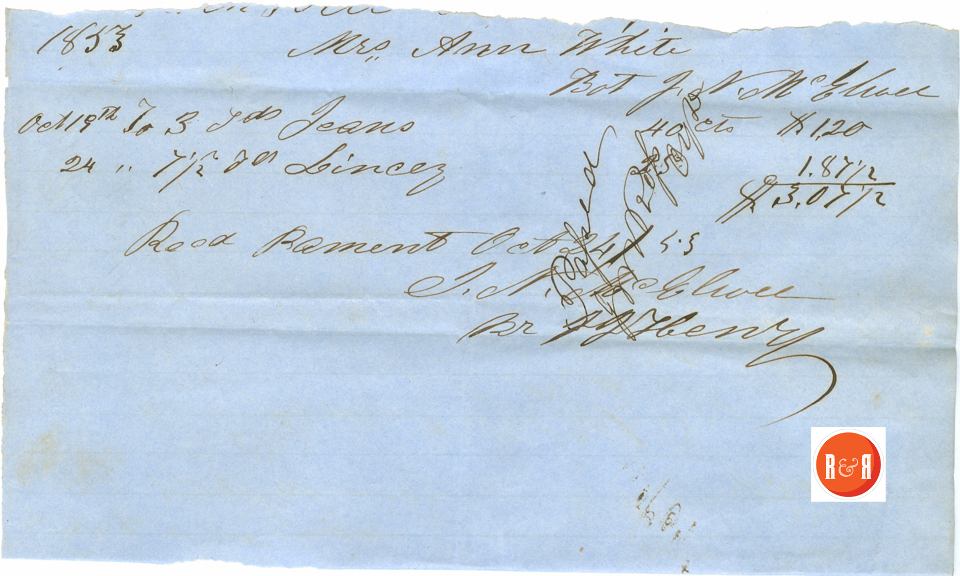
Payment for cloth to J.N. McElwee of Rock Hill in 1853 by Ann White. Courtesy of the White Family Collection – 2008

Image of J.N. McElwee – Courtesy of the Rhea Collection – AFLLC
When his health was failing, Ira Ferguson sold Lot 2 North to Andrew J. Smith of Chester District, S. C., on December 17, 1852, for $300. And then, on April 1, 1853, Andrew Smith sold the lot, measuring 103’ x 212’ to Jonathan N. McElwee, Jr., who lived south of Rock Hill at Taylor’s Creek, now known as Mount Holly, S. C., where he operated another general store. Almost immediately, Captain McElwee built a frame storehouse and went into the mercantile business at this site. His was one of the well-known places of business in the little village and it became a gathering place for the men of the community. His store building was located at the front of the lot, next to the street. The back of the lot, together with the back land of Lots 3 and 4, also owned by McElwee, was covered with large, beautiful trees. It was here that the farmers and tradesmen who came to town from time to time tied their horses. In hot weather McElwee’s Grove was a blessed place of relief from the Carolina sunshine. This backlot oasis stretched behind the stores fronting on Main Street some 300 feet.

Advertisement from the 1938 Rock Hill Bearcat annual.
After the Civil War Captain McElwee suffered financial difficulties, and his holdings in Rock Hill were put on the auction block. Beginning about 1866 and continuing for several years, the McElwee store-house on this lot was occupied by Major John Rutherford London as a mercantile establishment. Major London had just recently moved to Rock Hill from Yorkville. After he decided to move his operation to the Steele-Hutchison corner (the southeast corner of White and Depot streets) Captain McElwee, stepped in and took over the management of the elder man’s affairs. He sold 40’ of Lot 2 North to A. Friedheim and Brother [Arnold and Julius Friedheim]. This was the portion of the lot that was just east of Lot 1 North. Friedheim’s Store was housed in a new structure here. The sale to the Friedheim’s took place on January 17, 1880.
On this same date J. Lewis McElwee conveyed 60’ of the same lot to the well-known Rock Hill druggist, Thomas C. Robertson, who kept 34’ for his own purposes and sold a lot of 26’ to Mrs. Janie R. (Dudley) Smith, wife of Captain A. E. Smith, late of the Confederate Army, including an 8-foot alley that ran along the eastern side of the newly conveyed lot. It was here that the Smith-Fewell Company was operated for many years. This portion of Lot 2 North is historically important, since it was the portion on which stood the original McElwee’s Store, from 1853. In recent years this interesting site was home to a dress shop, Leader’s.
At this point we must pause to explain why there was so much real estate activity in the neighborhood of the McElwee property. As stated above, on the night of June 3-4, 1878, a disastrous fire burned all the buildings from J. A. Williford’s residence on Depot Street around the corner and up to and including McElwee’s Store on Main Street. Eventually Friedheim’s Store had a new building. So did Robertson’s Drugstore (a three-story structure, the Masonic Lodge using the third floor). Captain W. L. Roddey erected a new three-story building on the corner lot at Main and Depot streets. An opera house was included in the design. And there were still other improvements on Depot Street.

Ad from the 1938 Rock Hill Bearcat annual.
The original town well was located in the middle of Main Street just in front of McElwee’s Store. A pump was used in the well from its beginning; a new and improved pump was installed in 1880.
An interesting series of real estate changes involving Friedheim’s Store took place in the years from 1886 to 1898. Friedheim’s was first located on the north side of Main Street. A disastrous fire prompted Arnold Friedheim to move his store to the south side of the street. Another fire in the new location dictated a move across the street to the north side again. A new building there (1880) was burned to the ground in the great fire of 1898. At that time Friedheim’s erected a very large and impressive store. That building has survived to the present time. [Information provided via Along the Land’s Ford Road – Vol. I, 2008 by William B. White, Jr.]
The RH Herald contained an ad on Feb. 5, 1880 which stated, “I am fitting up a room over the drugstore of Robertson and Johnson for the purpose of taking photographs. There is a skylight, first class photographs taken. – N.W. Taylor”
The Yorkville Enquirer reported on July 23, 1885 – “A. Friedheim and Bro., are building a large brick warehouse in the rear of their store.”
The Herald reported on March 16, 1892 – “R.T. Fewell and August Friedheim have gone to the wholesale markets to purchase their stock of spring goods. S. L. Reid and A. E. Smith will soon follow.”
The Herald reported on April 1, 1896 – “Ms. Minnie Ratterree and Ms. Alice Adams conduct a fashionable millinery business over the drugstore of J. B. Johnson and Company.
The Herald reported on Aug 31. 1898 – “That A.E. Smith, J.W. O’Neal, B.M. Fewell and J.R. Sykes have applied for a charter for the Smith – Fewell Company, which will be a general merchandise business.”
The Herald contained a report on Jan. 18, 1899 – “The new building of the A. Friedheim and Brothers is said to be the finest mercantile building in the state. Construction is nearing completion and they are currently placing shelves and other interior appointments. The furnace is in place and the electric lights will soon be finished including 230 incandescent lamps.”
The Herald reported on Feb. 18, 1899 – “A. Friedheim and Brother are now in their new magnificent building. Construction was begun in mid June under the supervision of Hugh E. White, Architect and was completed last month. The front is of Washington Pressed Brick, with three heavy columns 18 ft high built of granite blocks measuring 2-3 feet. The vestibule has a Georgia marble floor. The display windows are lighted at night by electric arc lambs. The large skylight provides excellent light to the interior. The ceiling of the first story is decorated steel, painted in white, pink and gold by English artist, H.A. Browne.”
The Rock Hill Herald reported on April 1, 1899 – “The grand opening of the Smith – Fewell Company has been held. The building is two floors. Entertainment at the grand opening was provided by the Rock Hill String Band.”
The Herald reported on Sept. 12, 1900 – “Mr. W.H. Hoke of the Bend of the River farm is now employed with the Friedheim and Brothers.”
The RH Herald reported on June 24, 1899 – “Mr. M.H. Eichberg, representing a NY newspaper and the NY Trade Journal, came to Rock Hill Thursday and made photographs of the new store building of A. Friedheim. He said he had traveled all over the South and the Friedheim’s store is the best for light and arrangement all over the South.”
The Record reported on July 25, 1907 reported, “E.E. Cloud has acquired the entire dry goods stock of Smith – Fewell Co., the excludes groceries and supplies.”
The Rock Hill Record reported, March 26, 1913 – “The Smith Building on Main Street has been leased by the Efird’s, successful merchants who run a chain of dept. stores in N.C., and they will open business here as soon as the necessary changes can be made in the building. Architect N.G. Walker has made the plans for the improvement.”
The Record reported on Jan. 21, 1927 – “Saturday morning was the most disastrous fire in downtown Rock Hill in thirty years. It began in the Manhattan Cafe in the rear of the Rock Hill Drug Company, spread to the London Building (Cloud’s Store), the Rock Hill Drug Company and the J.L. Phillips Drug Company. Dr. J.E. Massey lost his instruments and library. The office of Dr. Blackmon, Strait, Massey, Hay, Walker, and Stevens, over the drug store were burned. Lyle Whitner lost all of his office equipment, located over Cloud’s Store. Frank D. Greene, the real estate agent saved the records in his office. John A. Black saved some of the records in his office. Flames endangered the National Union Bank, which also houses the Equitable and other private offices. On the other side, walls of the A. Freidheim and Brothers grew red hot but the fire did not penetrate.”
The Record reported on April 21, 1927 – “J.E. Healan, contractor, has started work on the new home for J.L. Phillips Drug Company on East Main Street. It will be a two story brick building with a basement. The second floor will have fifteen office spaces for doctors and other professionals. Plans were drawn by A.D. Gilchrist, local architect. ” (These are most likely the plans at WU’s Pettus Archives under the name of Sidney Friedheim for the year 1926)
Click on the More Information > link found below the picture column for a view of early downtown Rock Hill and the location of the McElwee Store in circa 1855. As well as the McElwee Store Ledger of clients holding accounts in 1915-16.
Comments per Tollison – Neal Drugs Store:
Peggy C. Reynolds wrote on Facebook 2013 – I worked at Tollison Neal Drug Store, on Main Street when I was in high school! I graduated in 1968 from Rock Hill High, the only high school at the time, (where Sullivan Middle School is now.) I cannot figure out where the store was, now. I live in Rock Hill now. Does anyone have a photo of it? I worked there after the soda fountain was removed. The boys from Robin’s Men Shop would come through the store to their annex store in the rear. Loved working there!
Robert W. Ratterree Sr. wrote on Facebook 2013 – I found a Hayward L. Robinson from Rock Hill born in 1909 and died in 2000. Hayward started out on a bicycle and in around 1960, they got Hayward a black 250 cc BSA motorcycle. I had a motor scooter and used to ride with Hayward. One day he let me drive that BSA and I loved it. Later I got my own big BSA. After a few years with the BSA he went to that VW from then on. The Herald had a big article on Hayward about the time he retired, and I am trying to find it. Everybody loved Hayward.
Jeanie Tibbetts Williams wrote on Facebook 2013 – I remember Phillips Drugstore being next door to the Stevenson Theater. It was owned by Cactus Phillips’ parents owned it then and their daughter Rosa worked there. The Phillips’ sold it to Henry Tollison and Dewey Neal., don’t remember the year. The next building that used to be owned by the Freidheim family was Graham’s Dept. Store before it was O’Sullivans.
Joshua Ward Westerlund – A contribution to R&R by J.P. Gettys, 2015
Mr. Westerlund (1851-1930) was a roofer or “tinner” who moved to Rock Hill in 1874 from Charleston. He was active in his trade for a number of years, and we have records of his work on several prominent buildings in Rock Hill.
Joshua Westerlund was the son of Captain Charles F. Westerlund (1817-1864) and his wife Martha. Charles Westerlund arrived in Charleston in 1847, an immigrant from Sweden. In the 1850 Census, he is listed as a “Master Mariner” and in 1860 as a “Sea Captain.” The 1854 Charleston City Directory lists the family at 6 Savage Street. Martha Randal King Westerlund was born in Charleston. The couple had at least four children, of whom Joshua was the youngest. Charles Westerlund served in the Civil War. One source sys that he was in Company F, South Carolina Ist Infantry (Charleston Reserves) and another says he attempted to run the Union blockade of Charleston with his cutter named Martin. He was killed in an unknown action on November 2, 1864. He is buried in Magnolia Cemetery in Charleston.
Joshua Westerlund is listed in the 1870 Census in Charleston and had recently married in Summerville to Eudora Jane Faris Westerlund. He is recorded as a tinner, and he and Eudora were living with his mother and two sisters. Joshua and Eudora and son Charles moved to Rock Hill in 1874. In the 1880 Census, he is listed as a tinner. Based on information currently available, the couple eventually had eight children. Son Charles (1871-1940) was also a tinner in the 1880 Census, although only nine years old. Charles would later go on to have a plumbing business and become a plumbing inspector for the City of Rock Hill. Two sons died at a young age: Oscar Ward (1874-1880) and Fred London (1884-1901). Daughter Etta Ward Westerlund married Efrom F. Fraley, who worked with his father-in-law as a tinner.
On January 14, 1891, the Rock Hill Herald reported that the selection of a candidate for the position of “winder and repairer of the town clock” was being considered by the City Council. The position paid $35 per year. J. W. Westerlund was one of two persons being considered. However, George Beach, a local jeweler, was selected.

Sanborn Insurance Map of the subject, 1926 – 1959. Behind the store on Main Street, ran a railroad spur to the warehouses found behind the store in what is in 2015 the city’s municipal parking lot. Courtesy of the Galloway Map Collection.
We have records of Mr. Westerlund being involved in the construction several important buildings in Rock Hill, including the
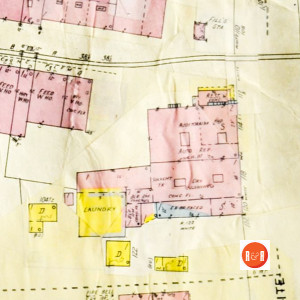
Sanborn Insurance Map of the subject, 1926 – 1959. Note these building were all part of the Friedheim complex extending behind the store and all the way to East White St., including the Friedheim’s public auditorium. Courtesy of the Galloway Map Collection.
Friedheim Building, 113 East Main Street (1898), and the installation of a slate roof on the home of A. C. Izard at 239 East White Street (1897). In 1899, the Westerlund Tin Shop was located on the Hutchison property between Main Street and Black Street. In 1914, his shop was described as opposite the freight depot, which would place it on Railroad Avenue (later Trade Street).
In the 1908 City Directory, the family is shown as living at 319 Green Street. In the 1910 Census, they are also on Green Street, and the household consists of Joshua, Eudora, and their daughter and son-in-law Etta and Efrom Fraley. An advertisement in the Rock Hill Herald on July 3, 1914 described J. W. Westerlund as a “General Metal Worker” and listed his skills as tin and slate roofing, galvanized shingles, gutter, and galvanized iron cornices.
By 1922, son-in-law Fraley had taken over the business. His advertisement in the City Directory of that year says that he is “Successor to J. W. Westerlund” and is a General Metal Worker. He advertised galvanized iron cornices and tin and slate roofing. His business was located on Chatham Avenue near White Street.

Friedheim Dept. Store staff stand in front of the lovely new business. Courtesy of the AFLLC Collection. The Charleston News and Courier reported on June 7, 1890 – “A. Friedheim and Bro., occupy and very large and handsome store, and do a large retail and whole sale business. The firm is composed of enterprising businessmen who have the highest financial standing and likewise the respect of the community in which they do such a large business. Their store is one of the largest in this section of the state, the firm also occupies two large and commodious warehouses.”
Eudora died in 1920. When Joshua died in 1930, he had been living for several years at 217 West Main Street in the household of the Fraleys. Survivors included daughters Mrs. J. L. Neville of Savannah, Mrs. T. M. Young of Asheville, and Mrs. Fraley, and sons Charles A. Westerlund of Rock Hill and A. M. Westerlund of Edgemoor. At his death, the Herald (July 11, 1930) described Mr. Westerlund as “An esteemed citizen…among what might be termed the old citizens of Rock Hill, one fully conversant with its early history, which he loved to recount with the interest natural to one who had lived through the formative years of the town. He was remarkably well-read, and possessed a library at one time which might well be the envy of the literati.” The funeral service was in the Fraley home, and was conducted by Rev. W. P. Peyton of the Episcopal Church of Our Saviour, where Westerlund was a long-time member. The burial in Laurelwood Cemetery was in charge of the Masonic lodge.
**** No better example of the business opportunities offered by the town of Rock Hill is afforded than in the career of Dr. J. B. Johnson. This gentleman came here from

An 1890 etching in the Charleston News and Courier of J. B. Johnson, one of Rock Hill’s leading businessman.
Yorkville, in 1872, a boy of thirteen upon his own resources, and generally speaking, without friends or money. In 1876 he secured a situation in the drug store of Dr. T. C. Robertson, at a salary of $4.50 per month. At that time there was not $500 worth of drugs in the town. Mr. Johnson worked faithfully, and at the end of two years service, were rewarded with a one-third, or working interest, in the business. The senior member of the firm retiring in I860, Dr. Johnson purchased his interest with a “promise to pay” $2,500. He is now free from incumbrances and has acquired considerable property outside. MEN OF THE TIME by J.C. Garlington
Click HOME to return to the numbered site tour of Rock Hill’s downtown.
ADDITIONAL DATA:
Architect, Hugh Edward White (1869 – 1939), who designed the store building, was born in Fort Mill, S.C. he attended Fort Mill Academy and later graduated from Clemson College in 1898. He started his practice in about 1894 prior to completing his formal education. His first plan was for the Friedheim Department Store of Rock Hill. According to a Rock Hill Research Paper #10 by Ms. Bessie L. Garrison – 1952, “White traveled with Julius and Sidney Freidheim to visit large store in New Orleans, Washington, Richmond, Baltimore, Philadelphia, and Chicago. The rotunda and balcony of the Freidheim store was designed after Wanamaker’s Store in Philadelphia and the facade from Maison Blanche in New Orleans. The stone on the facade came from a quarry in Winnsboro, S.C. ” Remained in Rock Hill until about 1903 and later returned to work. In the 1890’s he worked in an architectural firm in Atlanta. Between 1903-1918 he was a field supervisor of the Supt. Architect Dept. of the Treasury. For about three years 1918-21, he was employed with Charles Coker Wilson in Columbia or Gastonia, N.C.
The Crawford home cost $3,000. to construct 1899. Information from: The SC Architects: 1885 – 1935 by John E. Wells and Robert E. Dalton, 1992
Stay Connected
Explore history, houses, and stories across S.C. Your membership provides you with updates on regional topics, information on historic research, preservation, and monthly feature articles. But remember R&R wants to hear from you and assist in preserving your own family genealogy and memorabilia.
Visit the Southern Queries – Forum to receive assistance in answering questions, discuss genealogy, and enjoy exploring preservation topics with other members. Also listed are several history and genealogical researchers for hire.
User comments welcome — post at the bottom of this page.
Please enjoy this structure and all those listed in Roots and Recall. But remember each is private property. So view them from a distance or from a public area such as the sidewalk or public road.
Do you have information to share and preserve? Family, school, church, or other older photos and stories are welcome. Send them digitally through the “Share Your Story” link, so they too might be posted on Roots and Recall.
User comments always welcome - please post at the bottom of this page.

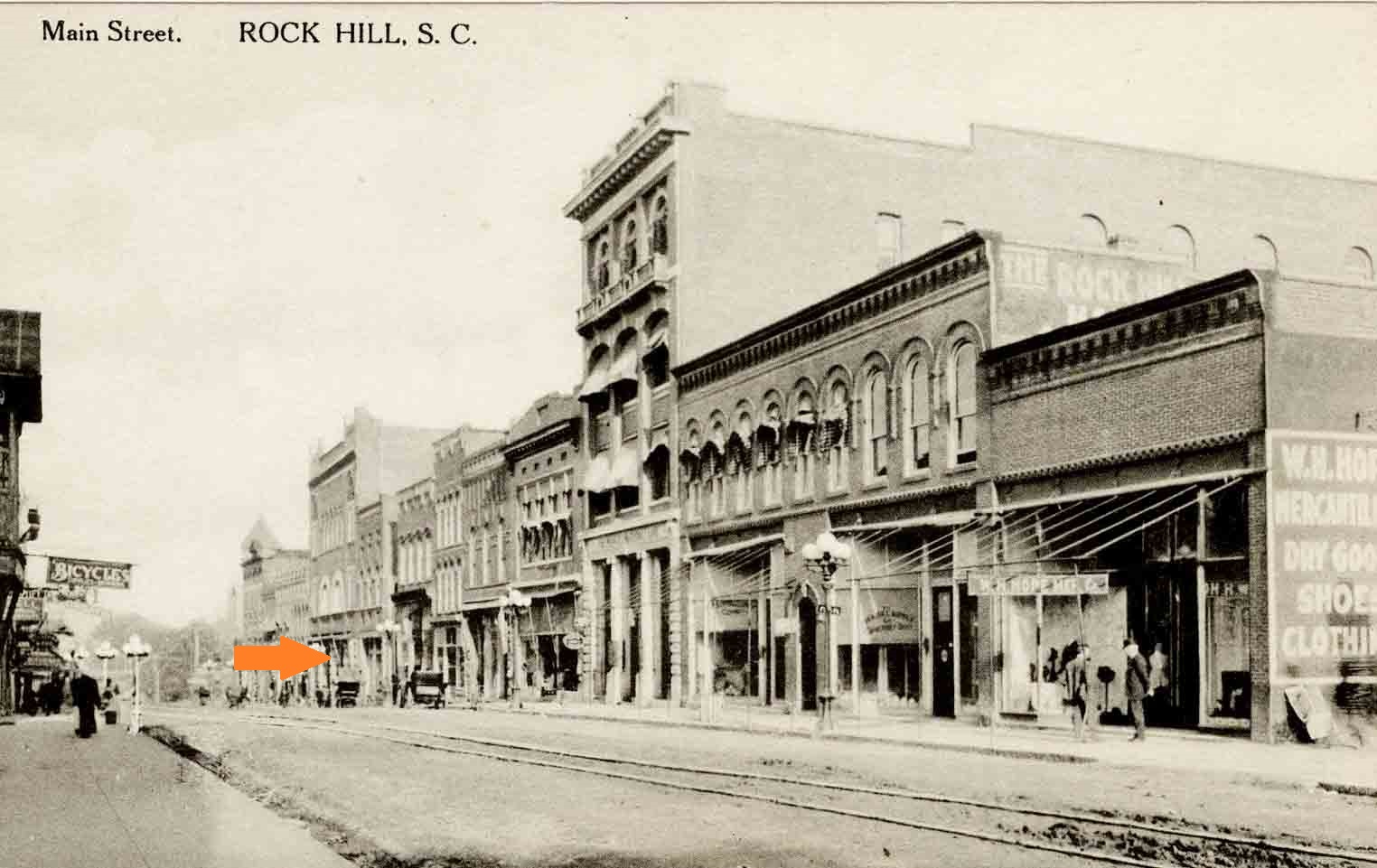






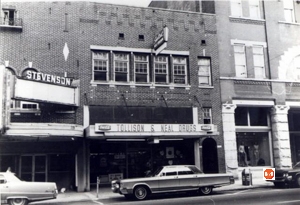










I have a pair of shoes manufactures by A. Friedheim Bros , Rock Hill. S.C. They are ladies old button up shoes, really small foot. It gives different numbers inside shoes which of course does not make sense to me.. Sole of shoes also has their names and ‘Bench Made. We have had them probably 40 years or so. And love them. They have been tucked away and we recently decided g-grandchildren were old enough not to bother them.